You're using an outdated browser. Please upgrade to a modern browser for the best experience.

Submitted Successfully!
Thank you for your contribution! You can also upload a video entry or images related to this topic.
For video creation, please contact our Academic Video Service.
| Version | Summary | Created by | Modification | Content Size | Created at | Operation |
|---|---|---|---|---|---|---|
| 1 | Huawei Zhang | -- | 5547 | 2024-02-07 15:11:20 | | | |
| 2 | Jason Zhu | Meta information modification | 5547 | 2024-02-08 03:10:27 | | |
Video Upload Options
We provide professional Academic Video Service to translate complex research into visually appealing presentations. Would you like to try it?
Cite
If you have any further questions, please contact Encyclopedia Editorial Office.
Zhang, H.; Liu, Z.; Sun, W.; Hu, Z.; Wang, W. Novel Alkaloids from Marine Streptomyces spp.. Encyclopedia. Available online: https://encyclopedia.pub/entry/54858 (accessed on 25 December 2025).
Zhang H, Liu Z, Sun W, Hu Z, Wang W. Novel Alkaloids from Marine Streptomyces spp.. Encyclopedia. Available at: https://encyclopedia.pub/entry/54858. Accessed December 25, 2025.
Zhang, Huawei, Zijun Liu, Wenyan Sun, Zhe Hu, Wei Wang. "Novel Alkaloids from Marine Streptomyces spp." Encyclopedia, https://encyclopedia.pub/entry/54858 (accessed December 25, 2025).
Zhang, H., Liu, Z., Sun, W., Hu, Z., & Wang, W. (2024, February 07). Novel Alkaloids from Marine Streptomyces spp.. In Encyclopedia. https://encyclopedia.pub/entry/54858
Zhang, Huawei, et al. "Novel Alkaloids from Marine Streptomyces spp.." Encyclopedia. Web. 07 February, 2024.
Copy Citation
Natural alkaloids originating from actinomycetes and synthetic derivatives have always been among the important suppliers of small-molecule drugs. Among their biological sources, Streptomyces is the highest and most extensively researched genus. Marine-derived Streptomyces strains harbor unconventional metabolic pathways and have been demonstrated to be efficient producers of biologically active alkaloids; more than 60% of these compounds exhibit valuable activity such as antibacterial, antitumor, anti-inflammatory activities.
marine Streptomyces
alkaloid
indole
pyrrole
pyridine
amide
anti-microbial effect
1. Introduction
Extensive marine habitats differ greatly from the land in terms of temperature, pressure and inorganic salt content, thereby providing a wealth of ecological and biogenetic diversity [1]. Benefiting from technological advances in deep-sea resource extraction and microbial culture methods, the number of new microbial species with unique metabolisms has constantly expanded in recent years [2]. Natural products of marine microbial origin are more likely to have novel skeletons and significant pharmacological activity [3]. It is estimated that at least 30,000 compounds with therapeutic potential have been isolated from marine microorganisms; some of these substances have been used as lead compounds or biomaterials in new therapies such as drug-resistant cancer treatment [4][5]. Actinomycetes are one of the largest phyla of bacterial groups and are ubiquitous in both terrestrial and marine ecosystems [6]. Their biosynthetic gene clusters (BGCs) have well-known abilities in the metabolization of complex natural products [7]. Streptomyces, as the largest and most advanced genus of actinomycetes, is the source of 60% of natural antibiotics, and classic examples widely are used in clinical practice, including erythromycin, streptomycin and rifamycin [8][9]. In the past thirty years, the number of novel metabolites produced with marine Streptomyces as a percentage of the total source has increased from 23.0% to 40.1% per decade (Figure 1), suggesting that these Streptomyces strains play an increasingly important role in the production of new natural products.
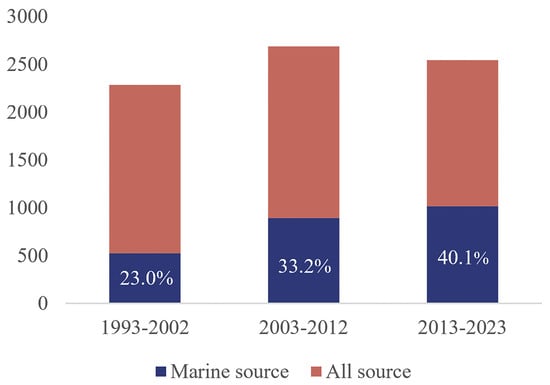
Figure 1. Source and statistics of new compounds from Streptomyces over the past three decades.
Alkaloids are the main chemical constituents in the secondary metabolites (SMs) of actinomycetes, and one of the compounds known to have the highest degree of druggability [10]. Most of these nitrogen-containing molecules have complex ring structures with promising pharmacological activity [11]. It has been demonstrated that marine alkaloids have widely clinical application value in the treatment of cancer, microbial infection, cardiovascular disease, inflammation, etc [12]. With the development of microbial genomics and metabonomics, the biosynthetic potential of marine Streptomyces has been deeply explored in the past decade. Three core databases (Web of Science, SciFinder and Dictionary of Natural Products) were used to search the targeted literature pertaining to specific topics related to marine and Streptomyces as well as novel or new alkaloids. According to their chemical structures, these metabolites (1–261) are grouped into nine types including indole, pyrrole, oxazole and thiazole, pyridine, pyrazine and piperazine, phenazine and phenoxazine, indolizidine and pyrrolizidine, amide and miscellaneous alkaloids. It is notable that indole, pyrrole, pyridine and amide are the major types, accounting for 72.9% of marine Streptomyces-derived novel alkaloids (Figure 2a). In addition, Streptomyces strains isolated from marine sediments have a numerical advantage (Figure 2b); the number of new alkaloids produced by marine Streptomyces had a short-lived upward trend, but has fallen in the last two years (Figure 2c).

Figure 2. (a) Structural classes of marine Streptomyces-derived alkaloids reported in January 2013–June 2023; (b) sources of marine Streptomyces strains; and (c) number of new alkaloids discovered between January 2013–June 2023.
2. Indoles
Indoles are bicyclic alkaloids that usually use tryptophan or tryptamine as biosynthetic precursors [13]. They are common and grow rapidly in the SMs of marine-derived microorganisms with a wide range of biological activities [14]. Compounds 1–55 have been described as indole alkaloid derivatives of marine Streptomyces origin, including bisindole, indole sesquiterpenoid, and other miscellaneous indoles.
2.1. Bisindoles
Bisindole alkaloids represent a family formed by the oxidation and polymerization of two L-tryptophan molecules, which have more pronounced biological activities compared to the indole monomer structure [15]. These alkaloids have been reported to have cytotoxic, antibacterial, and antiviral activities; bisindole derivatives containing triazine groups have been used as targeted pyruvate dehydrogenase kinase (PDK) inhibitors in the treatment of pancreatic ductal adenocarcinoma [16][17].
2.1.1. Staurosporines
The potent protein kinase C (PKC) inhibitor (IC50 = 2.7 nM) staurosporine containing the indolo[2,3-a]carbazole structure was first discovered in S. staurosporeus in 1977 [18]. Lately, several analogues have been isolated and approved for clinical use, such as midostaurin and lestaurtinib [19]. Compounds 1–4 (Figure 3) are marine Streptomyces’ staurosporine derivatives with significant selective inhibition of Rho-associated protein kinase (ROCK2), PKC and Brution tyrosine kinase (BTK) [20][21]. A biosynthesis study indicated that the C-N bond linking the aglycone and deoxysugar moiety of staurosporine is catalyzed by cytochrome P450 enzymes [22]. Twelve holyrine A derivatives (5–16, Figure 3) displayed strongly or moderately cytotoxic and enzyme-inhibitory activity, with IC50 values ranging from 0.0057 to 16.6 µM [21][23][24][25]. When cultured in a liquid medium with 5-hydroxy-L-tryptophan precursors, strain Streptomyces sp. OUCMDZ-3118 was shown to produce another analogue 3-hydroxy-K252d (17, Figure 3), which demonstrated cytotoxicity against A549 and MCF-7 cell lines with IC50 values of 1.2 ± 0.05 µM, 1.6 ± 0.09 µM, respectively [26].
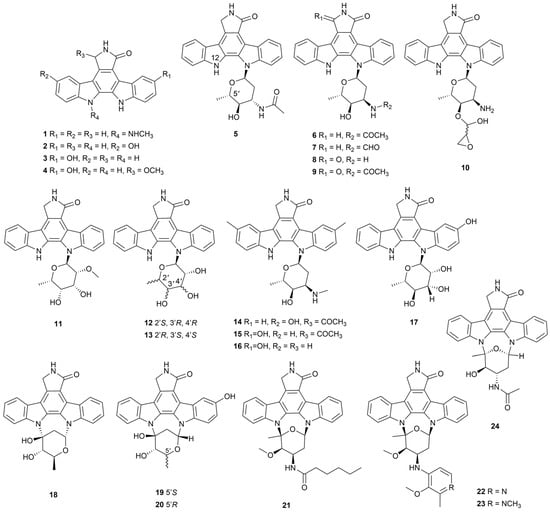
Figure 3. Chemical structures of staurosporine analogues 1–24 isolated from marine Streptomyces.
Moreover, streptocarbazoles C–H (18–23, Figure 3) were extracted from Streptomyces sp. DT-A65, DT-A61 and OUCMDZ-5380 [21][25][27]. Streptocarbazoles D and E rarely contained a hydroxyl group at the C-3 position. Compound 20 inhibited a PC3 cell line with an IC50 value of 5.6 μM, while compounds 21–23 inhibited acute myeloid leukemia cell line MV4-11 (IC50 = 0.81–1.88 µM). In addition, strain DT-A61 collected another staurosporine analogue (24, Figure 3), which exhibited extremely potent cytotoxic activity against PC3 cells with an IC50 value of 0.16 μM [21]. The structure–activity relationship (SAR) analysis showed that staurosporine analogs with a glycosyl unit double-linked to the aromatic aglycone by two C-N bonds displayed better biological effects.
2.1.2. Halogenated Bisindoles
All bisindoles from marine Streptomyces are chlorinated (25–39, Figure 4). Indimicins A−E (25–29) and lynamicins F–G (30 and 31) were obtained from a deep-sea-derived Streptomyces sp. SCSIO 03032 by solid phase extraction with XAD-16 resin [28]. These compounds had unusual 1′,3′-dimethyl-2′-hydroindole structures. Only dimethyl-substituted indimicin B (26) was seen to have antitumor activity against the MCF-7 cell line with an IC50 value of 10.0 μM. In order to characterize the function of gene spmH, which was predicted to be an L-Trp 5-halogenase, the authors inactivated this gene in strain SCSIO 03032 and obtained four bisindoles without a halogen substituent named spiroindimicins G–H (32–33) and indimicins F–G (34–35) [29]. It was confirmed that spmH functioned as halogenase and acted in early biosynthesis using L-Trp as a substrate. Compounds 32 and 33 showed various degrees of cytotoxicity against four cancer cell lines (SF-268, MCF-7, HepG2 and A549) and the presence or absence of chlorine atoms had no significant effect on the cytotoxic activity.
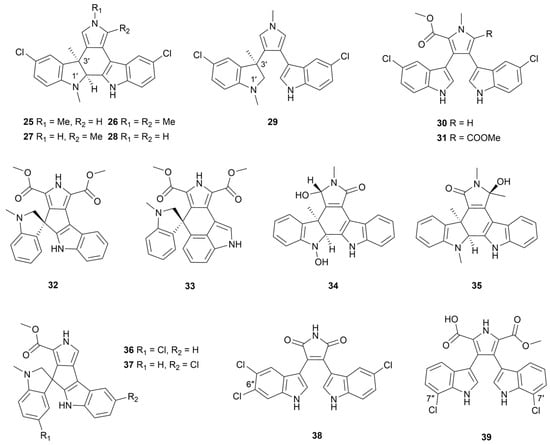
Figure 4. Chemical structures of halogenated bisindoles 25–39 isolated from marine Streptomyces.
Two non-typical bisindole spiroindimicins E and F (36 and 37) were purified from the metabolites of strain MP131-18 with cluster 36 being predicted to be the gene cluster responsible for bisindole biosynthesis [30]. Only compound 36 showed weak cytotoxic activity against T24 bladder cancer cells, while 36–37 had no antimicrobial activity due to this type of effect was proportional to the amount of halogenation. In addition, Streptomyces sp. SCSIO 11791 produced two chlorinated bisindoles (38 and 39), which displayed moderate cytotoxicity against four tumor cells with IC50 values ranging from 2.9 μM to 19.4 μM [31]. Compound 38 additionally exhibited cytotoxic activity against MDA-MB-231 and NCI-H460 cell lines as well as inhibition of Gram-positive bacteria. The structure–activity relationship suggested that the substitution of the C-6″ position by the chlorine atom was more beneficial to the biological activity.
2.2. Indole Sesquiterpenoids
The first bacterial-derived indole sesquiterpenoid alkaloid, named xiamycin, was isolated from an endophytic Streptomyces sp. from B. gymnorrhiza in 2010 [32]. In recent years, compounds of this family have been found in marine Streptomyces, and have attracted attention because of their antibacterial, anti-human-immunodeficiency-virus (HIV) and anti-tumor activities [33]. Xiamycins C–E (40–42, Figure 5) were isolated from Streptomyces sp. HK-18 [34]. Compounds 41 and 42 exhibited strong activity against the replication of porcine epidemic diarrhea virus (PEDV) in a dose-dependent manner, with EC50 values of 0.93 μM and 2.89 μM, respectively. The mechanism of action inhibited the synthesis of key structural proteins for PEDV to prevent virus replication. The methyl ester group was an important functional group to maintain activity. Overexpression of the orf2011 gene encoding the LuxR family regulator in the Streptomyces sp. HK-18 resulted in the production of two members of the xiamycins family containing an N-O bone linked aliphatic chain structure named lipoxiamycins A and B (43 and 44, Figure 5) as well as increased production of xiamycins dimers dixiamycins A and C (45 and 46, Figure 5) [35]. An anti-inflammatory assay showed that compounds 43 and 45 could significantly inhibit the production of lipopolysaccharide-induced NO with IC50 values of 9.89 ± 0.92 and 4.12 ± 0.22 μM, respectively.
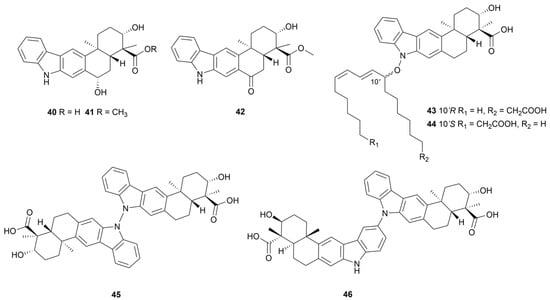
Figure 5. Chemical structures of Indole sesquiterpenoids 40–46 isolated from marine Streptomyces.
2.3. Other Indoles
The first naturally derived indolinone-naphthofuran alkaloids, (±)-Pratensilins A–C (47–49, Figure 6), were isolated from Streptomyces pratensis KCB-132 obtained from a marine sediment from the Bohai Sea, China [36]. Only compound 47 displayed moderate cytotoxicity against eight human cancer cell lines (IC50 = 2.4 μM–67.4 μM), with small steric substituents in R2 and R3. After adding 50 µM of lanthanum chloride to the liquid medium, an indolinone-naphthofuran analogue (±)-Pratensilin D (50, Figure 4) was detected in the metabolites [37]. (-)-Pratensilin D (50) exhibited more potent biological activity against Gram-positive bacteria, yeast and five human cancer cell lines. One anthranilate-containing alkaloid, anthranosides C (51, Figure 6), was separated from a sponge-derived Streptomyces sp. CMN-62 (Naozhou Island, China) and exhibited a 171 μM IC50 against the influenza A H1N1 virus [38]. Four indole alkaloids streptoindoles A–D (52–55, Figure 6) were obtained from Streptomyces sp. ZZ1118 rice solid medium derived from a gut sample of marine shrimp (Penaeus sp.) [39]. Compound 54 potently inhibited E. coli and C. albicans (MIC = 7 μg/mL) and compound 55 was weakly active against methicillin-resistant Staphylococcus aureus (MRSA) only (MIC = 25 μg/mL). Compounds 52 and 53 were effective against all three pathogens, with MIC values of 7–25 μg/mL.

Figure 6. Chemical structures of other indoles 47–55 isolated from marine Streptomyces.
3. Pyrroles
Pyrrole alkaloids have more potential to be designed as lead compounds due to their property of easily forming hydrogen bonds [40]. Marine pyrrole derivatives usually have more unique structures and significant pharmacological activities such as antimicrobial, antiproliferative, anti-inflammatory and antiviral activities [41].
3.1. Pyrrolones and Pyrrolidones
This part describes cases in which pyrrole or pyrrolidine pentacyclic rings are replaced by carbonyl groups. The formed pyrrolone and pyrrolidone structures are crucial heterocyclic pharmacophores in medicinal chemistry, with significant biological activities [42]. The tirandamycins are a class of bacterial RNA polymerase (RNAP) inhibitors containing dienoyl tetramic acid and 2,4-pyrrolidinedione structures [43]. Two tirandamycin analogues tirandamycin K and isotirandamycin B (56 and 57, Figure 7), together with two known derivatives (58 and 59, Figure 7), were produced from marine Streptomyces strains [44][45]. Compound 56 was the first linear tirandamycin derivative that avoided bicyclic ketal ring formation due to the inability of the C-9S hydroxyl group to be nucleophilically attacked by C-13. In a pathogenic bacterial inhibitory activity assay, compounds 57–59 showed obvious antibacterial activity against S. agalactiae with MIC values of 2.5–5.0 μg/mL. However, compound 56 was inactive, therefore the authors deduced that the bicyclic ketal ring moiety was a necessary RNA polymerase target.
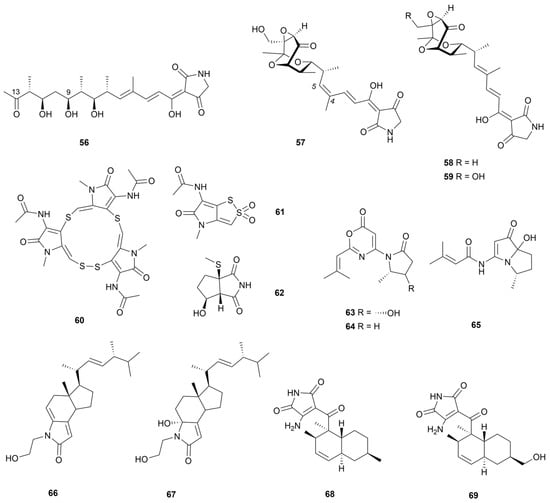
Figure 7. Chemical structures of pyrrolone and pyrrolidone alkaloids 56–69 isolated from marine Streptomyces.
Three thio-containing pyrrolone-based alkaloids (60–62, Figure 7) were discovered from two marine Streptomyces [46][47]. Thiolopyrrolone A (60) had an unusual macrocyclic skeleton and also inhibited Bacille Calmette–Guérin (BCG), M. tuberculosis, and S. aureus, with MIC values of 10, 10 and 100 µg/mL, respectively. Bacillimide (62) had a rare cyclopenta[c]pyrrole-1,3-dione structure bearing a methylsulfide group. This pyrrolidone alkaloid was an isocitrate lyase (ICL) enzyme moderate inhibitor under C2-carbon-utilizing conditions, demonstrating an IC50 value of 44.24 µM against C. albicans. In addition, Streptomyces sp. KMF-004 yielded two unusual pyrrolidinyl-oxazinone alkaloids, Salinazinones A and B (63 and 64, Figure 7) [48]. Compound 64 showed an inhibitory effect on lipopolysaccharide (LPS)-induced NO production by BV-2 microglia cells (an IC50 value of 17.7 μM). The authors speculated that the oxazinone structure was synthesized by amide cyclization and gave a possible biosynthetic intermediate named bohemamine D (65). Anandins A and B (66 and 67, Figure 7), as two unique pyrrolidone-containing steroidal alkaloids, were isolated from Streptomyces anandii H41-59 derived from mangrove sediments [49]. The compound 66 showed moderate inhibitory effects against cancer cell lines MCF-7, SF-268 and NCI-H460 (IC50 = 7.5–7.9 µg/mL, respectively). Two pyrrolidone derivatives, ligiamycins A and B (68 and 69, Figure 7), were obtained by co-culture of two marine-derived strains Streptomyces sp. GET02.ST and Achromobacter sp. GET02.AC [50]. A biological evaluation showed that compound 68 exhibited moderate effects against S. aureus and S. enterica (both MIC values of 16 µg/mL), while compound 69 was cytotoxic against HCT116 cancer cells (IC50 = 20.1 µM). The presence of the hydroxyl group in compound 69 had an opposite effect on antitumor activity and antibacterial activity.
3.2. Pyrrolobenzodiazepines
Pyrrolo[1,4]benzodiazepines (PBDs, Figure 8) are tricyclic alkaloids that can be divided into [2,1-c][1,4], [1,2-a][1,4] and [1,2-d][1,4] structural types according to the different positions of the pyrrole ring-binding [51]. Natural PBDs are originally derived from Streptomyces as DNA alkylating antitumor drugs, and the classical representatives are anthramycin, sibiromycin and tomaymycin [52]. A pyrrolobenzodiazepine alkaloid, oxoprothracarcin (70), was produced by Streptomyces sp. M10946 obtained from a mangrove sediment [53]. Compound 70 had antiproliferative effects against MDA-MB-231 cells and A549 cells at 10 μM, with growth inhibition rates of 10.2% and 7.3%. An unusual PBD derivative, 7-methoxy-8-hydroxy cycloanthranilylproline (71), along with a known analogue (72), was isolated from marine S. cacaoi 14CM034 and displayed antimicrobial effects on E. coli, MRSA, E. faecium, P. aeruginosa and C. albicans, with MIC values ranging from 8.75 to 32 µg/mL [54]. It seems that methoxy substitution on the benzene ring of PBD diminished the antimicrobial effect.

Figure 8. Chemical structures of pyrrolobenzodiazepines 70–72 isolated from marine Streptomyces.
3.3. Ansamycins
Ansamycins are a class of important macrocyclic lactam alkaloids obtained mainly from actinomycetes, of which the more representative include the anti-tuberculosis drug laofomycin, Hsp90 inhibitor geldamycin, and anticancer drug ansamitocin P-3 [55]. According to the different aromatic cores, ansamycins can be divided into benzene series and naphthalene series [56]. Hygrocins are a subclassification of naphthalenic ansamycins, whose amides are five-membered or seven-membered nitrogen heterocycles [57]. After knocking out the gene gdmAI responsible for the synthesis of the high-yield ansamycin analogue geldanamycin in Streptomyces sp. LZ35, hygrocins C−F (73–76, Figure 9) were produced and characterized [58]. In 2015, strain LZ35 was genetically modified by overexpression of hgc1, a LAL-type activator, and was found to produce three hygrocin derivatives, hygrocins H–J (77–79, Figure 9) [59]. Compounds 73, 74, 76 and 77 were shown to be cytotoxic to MDA-MB-231, PC3 and HeLa cell lines, with IC50 values of 0.5–5.0 μM. Streptomyces sp. ZZ1956 afforded nine derivatives named hygrocins K–S (80–88, Figure 9) [60]. Compounds 83, 86 and 87 showed antiproliferative activity against human glioma U87MG and U251 cells with IC50 values of 7.04-10.46 μM. In addition, compounds 83, 84, and 87 displayed antibacterial activity against MRSA and E. coli (MIC = 8–24 µg/mL). The E configuration of C-3 and C-4 double bond and the existence of the ansa ring in these molecules are the keys to their strong biological activity.

Figure 9. Chemical structures of ansamycin analogues 73–95 isolated from marine Streptomyces.
Three ansamycin derivatives with unprecedented skeletons, ansalactams B–D (89–91, Figure 9), were isolated from marine sediment-derived Streptomycetes sp. CNH189 [61]. Antibacterial activity tests showed that compounds 89–91 had weak inhibitory activity against MRSA, with MIC values of 31.2, 31.2, and 62.5 μg/mL, respectively. A chemical study of the strain Streptomyces sp. KFD18 produced four ansamycin analogues named divergolides T–W (92–95, Figure 9) [62]. All these substances showed various degrees of cytotoxic activity against cancer cell lines SGC-7901, K562, Hela and A549; compounds with hydroxylation of C-7 and R configuration of C-2 exhibited weak cytotoxic effect.
3.4. Other Pyrroles
Chlorizidine A (96, Figure 10), biosynthesized based on the non-ribosomal peptide synthetases/polyketide synthases (NRPS/PKS) pathway, was an unprecedented alkaloid containing chlorinated 5H-pyrrolo[2,1-a]isoindol-5-one fragment [63]. It exhibited an IC50 value of 3.2–4.9 μM against the HCT-116 adenocarcinoma cell line with the pyrrole isoindolone ring moiety as a key pharmacophore. Isolated from marine sediment samples, the S. zhaozhouensis 208DD-064 produced two halogenated pyrroles, streptopyrroles B and C (97 and 98, Figure 10) [64]. Compounds 97 and 98 showed promising activity with three Gram-positive bacteria (MIC = 0.7–2.9 µM), with inverse correlation to the number of halogen substituents. Moreover, streptopyrrole B (97) exhibited moderate activity against six cancer cell lines. Three pyrrole ether compounds of the indanomycin family (99–102, Figure 10) were isolated from S. antibioticus PTZ0016 extracts based on antimicrobial activity [65]. A biological evaluation showed that compounds 99–102 inhibited the growth of S. aureus with MIC values of 4.0–8.0 µg/mL. Nitricquinomycins A–C (103–105, Figure 10) arethe first example of naphthopyrroledione derivatives containing an angolosamine moiety and 105 had a significantly inhibitory effect on A2780 cell lines (IC50 = 4.77 µM) and moderate activity against E. coli, S. aureus and C. albicans (MIC values of 20–40 µM) [66]. In 2021, a nitricquinomycin analogue, bhimamycin J (106), was purified from Streptomyces sp. MS180069 and demonstrated 79.7% inhibition of angiotensin converting enzyme 2 (ACE2) at 25 μg/mL [67]. Isolated from a deep-sea floor, the Streptomyces sp. GGS53 produced two pyrrolosesquiterpenes glaciapyrroles, D and E (107 and 108, Figure 7) [68]. Influenza A viruses were used to infect Mardin–Darby canine kidney cells; 108 exhibited significant antiviral activity, resulting in the reduction of the viral titer by 70%.

Figure 10. Chemical structures of other pyrroles 96–108 isolated from marine Streptomyces.
4. Oxazoles and Thiazoles
Oxazole and thiazole rings exhibit a wide range of pharmacological activities, such as antiproliferative, anti-inflammatory and antimicrobial activity, by binding non-covalently to many enzyme and receptor targets [69][70]. Most of these alkaloids have been mentioned in other chapters, and this chapter summarizes the remaining five compounds 109–113 (Figure 11). Under LC-MS/MS molecular networking guidance, five siderophores containing oxazole or thiazole rings were isolated from S. diastaticus NBU2966 collected from marine sponge Axinellida sp. [71]. However, none of these metabolites demonstrated activity against S. aureus, MRSA, B. subtilis, and P. aeruginosa.

Figure 11. Chemical structures of oxazole and thiazole alkaloids 109–113 isolated from marine Streptomyces.
5. Pyridines
5.1. Piericidins
Piericidins are a class of 4-pyridinol alkaloids decorated with methylated polyene side chains, mostly isolated from actinomycetes of soil, marine or bio-symbiotic origin [72]. Due to structural similarities with coenzyme Q, some piericidins exhibit NADH−ubiquinone oxidoreductase inhibitory activity [73]. Moreover, insecticidal, cytotoxic, and bactericidal effects of piericidins have been reported. When a mangrove soil-derived Streptomyces sp. CHQ-64 was knocked out of the gene rdmF, a positive regulatory gene for reedsmycins (polyol polyene macrolides), one mutant strain was shown to produce a piericidin analogue (114, Figure 12), which displayed prominent cytotoxicity against the HeLa, NB4, A549 and H1975 cell lines (IC50 values of 0.003–0.56 μM). Seventeen piericidin derivatives (115–131, Figure 12) purified from S. psammoticus SCSIO NS126 from mangrove sediment samples showed strong or moderate activity against renal cell (RCC) carcinoma cell line ACHN with IC50 values of 0.31–60 μM [74]. A mechanism-of-action (MOA) study revealed that compounds 115–131 could increase the expression of peroxiredoxin 1 (PRDX1), decreasing the level of reactive oxygen species in cells. The piericidin glycosides (119–131) were more effective in binding to PRDX1 than the aglycones (115–118), although ultimately there was no significant difference in antitumor activity. Piericidin A5 (132) together with G1 (133) produced by strain SCSIO 40063 exhibited antitumor activity against SF-268, MCF-7, HepG2 and A549 tumor cell lines, with IC50 values ranging from 10.0 to 12.7 μM [75].
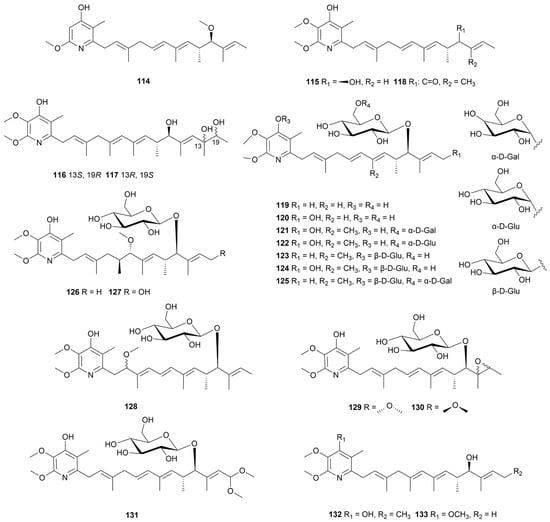
Figure 12. Chemical structures of piericidin analogues 114–133 isolated from marine Streptomyces.
5.2. Quinolines
Quinolines have been designed as important skeletons in drug structures for more than two centuries [76]. Classic examples are quinine, the first effective antimalarial drug in history, and the broad-spectrum antibiotic fluoroquinolone [77]. This subsection provides an overview of quinoline alkaloids of marine Streptomyces sp. origin and their derivatives isoquinolines and quinolones. Compounds 134–141 (Figure 13) were identified as simple quinoline alkaloids purified from marine Streptomyces. Strain CNP975 produced two rare quinoline derivatives containing 3-hydroxyquinaldic acid (3HQA) fragments, named actinoquinolines A and B (134 and 135), with stronger inhibitory activity against cyclooxygenases-2 (COX-2, IC50 of 2.13 and 1.42 μM, respectively) compared to cyclooxygenases-1 (COX-1, IC50 of 7.6 and 4.9 μM, respectively) [78]. The cyclization of the hydroxyl group increases the activity of the compounds against COX-1/2. Three amino-acid-substituted quinoline derivatives (136–138) were isolated by S. cyaneofuscatus M-157 collected from coral samples containing serine, glutamine, and cysteine residues unit, respectively [79]. Only compound 137 displayed weak cytotoxicity against human tumor cell line HepG2, with IC50 value of 51.5 µM. Diazaquinomycins E–G (139–141) were unusual diazaanthracene alkaloids, and compound 139, with double substitution, had cytotoxic activity against the ovarian cancer cell line OVCAR5 by upregulating the cell cycle inhibitor p21 and impairing DNA (IC50 value of 9.0 μM) [80]. Antichlamydial activity-guided purification of a chlorinated quinolone ageloline A (142, Figure 13) was isolated from Streptomyces sp. SBT345 collected from the Mediterranean sponge Agelas oroides [81]. Compound 142 dose-dependently exhibited inhibition of Chlamydia trachomatis growth (IC50 value of 9.54 ± 0.36 μM) by inhibiting reactive oxygen species (ROS) production during the early stages of infection. The high-yield extract medium of strain B1848 afforded three isoquinolinequinone alkaloids, mansouramycins E–G (143–145, Figure 13) [82]. In a cytotoxicity assay against 36 tumor cells, compound 144 exhibited selective moderate cytotoxic activity (mean IC50 value of 7.92 µM), while compound 143 exhibited weak effect.

Figure 13. Chemical structures of quinolines 134–145 isolated from marine Streptomyces.
5.3. Other Pyridines
Two pyridine derivatives, strepchazolins A and B (146 and 147, Figure 14), were purified from S. chartreusis NA02069 [83]. Compound 146 inhibited a 64.0 µM MIC value against B. subtilis and a 50.6 µM IC50 value against acetylcholinesterase. Compound 147 was inactive, indicating that steric configuration affected biological activity. Isolated from a marine mud sample, Streptomyces sp. ZZ741 afforded ten glutarimide analogues named streptoglutarimides A−J (148–157, Figure 14) [84]. All analogues were effective against MRSA (MIC = 9–11 μg/mL), E. coli (MIC = 8–12 μg/mL) and C. albicans (MIC = 8–20 μg/mL). The five-membered and six-membered rings in C-4 substituents had no significant effect on pharmacological activity. Moreover, 155 displayed promising antiproliferative activity against glioma cells U87MG and U251 with IC50 values of 3.8 ± 0.6 µM and 1.5 ± 0.1 µM, respectively.

Figure 14. Chemical structures of other pyridines 146–157 isolated from marine Streptomyces.
6. Pyrazines and Piperazines
6.1. Pyrazines
Owing to nitrogen atoms acting as hydrogen bonding acceptors and the structure being conducive to nucleophilic reaction, pyrazine is commonly used as a classical pharmacophore [85]. Pyrazine derivatives have been reported for applications as antitumor drugs, diuretics, anti-inflammatory and anti-infective drugs [86]. Griseusrazin A (158, Figure 15) was isolated from a strain S. griseus subsp. griseus 09-0144 and activated the expression of heme oxygenase 1 which inhibits the upstream NF-κB pathway [87]. Therefore, it could downregulate the expression of related enzymes inducible nitric oxide synthase (iNOS) and COX-2 at the transcriptional level as well as the production of inflammatory mediators NO and PGE2. Compounds 159–161 (Figure 15) were purified by Streptomyces sp. Did-27 isolated from the marine tunicate Didemnum sp., from which 159 and 161 showed weak cytotoxicity against HCT-116 and MCF-7 cancer cell lines with IC50 of 25–35 µg/mL [88]. Collected from a sample of coastal soil from Zhoushan Islands, China, the Streptomyces sp. ZZ446 afforded four pyrazinones of streptopyrazinones A–D (162–165, Figure 15) [89]. These compounds exhibit 35.0-60.0 µg/mL MIC values against C. albicans and 58.0-65.0 µg/mL MIC values against MRSA. In 2022, two pyrazines named actinopolymorphols E and F (166 and 167, Figure 15) were obtained from marine sediment-derived strain CNP-944 and only compound 167 exhibited weak activity against K. rhizophila, B. subtilis and S. aureus with MIC values of 16–64 µg/mL [90]. Compound 166 was inactive, which indicated that the carbonyl was the key active moiety.

Figure 15. Chemical structures of pyrazines 158–167 isolated from marine Streptomyces.
6.2. Diketopiperazines
Piperazine alkaloids of biological origin are most commonly of the 2,5-diketopiperazines (2,5-DKPs) type, with a cyclodipeptide structure formed by condensation of two amino acids [91]. These simple dipeptides reported for multiple biological activities have a flexible skeleton with multiple chiral centers and four hydrogen bonding sites [92].
A variety of 2,5-DKPs alkaloids (168–177, Figure 16) had been isolated and characterized from several marine Streptomyces spp. Compounds 168–170 were condensed with leucine and phenylalanine residues and purified by a Streptomyces sp. MNU FJ-36 obtained from the intestinal fabric of Katsuwonus sp. [93]. All compounds were weakly inhibitory to A549 and HCT-116 cell lines. Streptodiketopiperazines A (171) and B (172) containing phenylalanine residues were isolated from the Mariana Trench source Streptomyces sp. SY1965 [94]. Biological evaluation showed that 171 and 172 showed weak antifungal activity against C. albicans (MIC = both 42 μg/mL). A 2,5-DKPs dimer naseseazine C (173) had moderate inhibitory activity against chloroquine-sensitive Plasmodium falciparum (average IC50 value = 3.52 ± 1.2 µM) [95]. This dimer was connected by an unconventional C-6′/C-3 linkage and thus promoted antimalarial activity. Actinozine A (174) and cyclo(2-OH-D-Pro-L-Leu) (175) as two 2,5-DKP alkaloids were produced by Streptomyces sp. Call-36 from the Red Sea sponge Callyspongia sp. [96]. Compound 174 had a special hydroperoxy moiety on the proline residue. Antimicrobial assays against S. aureus and C. albicans revealed that 174 and 175 showed inhibition zones of 16-23 mm. Furthermore, a glycosylated 2,5-DKP (176) and its aglycone (177) showed inhibitory activity against MRSA, E. coli and C. albicans (MIC = 26.0–37.0 µg/mL) [97].
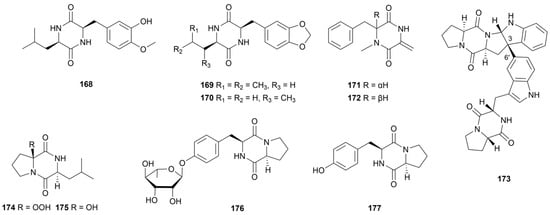
Figure 16. Chemical structures of diketopiperazines 168–177 isolated from marine Streptomyces.
7. Phenazines and Phenoxazines
Phenazines and phenoxazines are mainly derived from SMs of Streptomyces and Pseudomonas isolated from soil or marine habitats [98]. Most of these alkaloids are characterized by promising biological activities such as antibacterial, antiviral, antitumor and antiparasitic effects [99]. Six antitumor phenoxazines venezuelines A–E (178–182, Figure 17) and maroxazinone (183, Figure 17) were isolated from two sediments-derived Streptomyces [100][101]. Compound 179 showed moderate antitumor activity against five cancer cell lines with IC50 values of 5.74–9.67 μM and weak activity against human hepatoma cell Bel 7042 (IC50 >10 μM). Notably, the cytotoxicity of this compound may be explained by significant upregulation of the orphan nuclear receptor Nur77 (apoptosis-associated) expression. 183 showed moderate antiproliferative activity against MCF7, HEPG2 and HCT116 cell lines with IC50 values of 4.32, 2.90 and 8.51 μg/mL, respectively. Cytotoxic activity of phenoxazinones was stronger than phenoxazines and the increase of substituents weakened the activity. Sponges can host microorganisms colonization due to their porous structure, therefore the metabolites of sponge symbiotic microorganisms are important sources of marine natural products [102]. Streptomyces sp. HB202 was isolated from the sponge Halichondria panicea and yielded three phenazine alkaloids streptophenazines I–K (184–186, Figure 17) [103]. These compounds inhibited the activity of inflammatory response associated enzyme phosphodiesterase (PDE 4B) with IC50 values ranging from 11.6 to 12.2 μM. In addition, compound 186 had antibacterial activity against B. subtilis and S. epidermidis (IC50 = 21.6 ± 6.8 µM and 14.5 ± 2.0 µM, respectively).
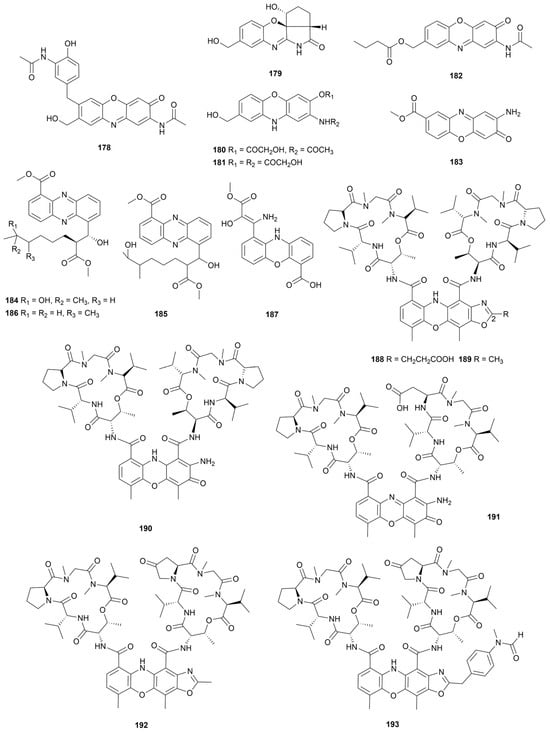
Figure 17. Chemical structures of phenazine and phenoxazine alkaloids 178–193 isolated from marine Streptomyces.
One phenoxazine derivative strepoxazine A (187, Figure 17) was produced by a strain SBT345 obtained from the mediterranean sponge Agelas oroides [104]. The IC50 value for 187 against promyelocytic leukemia cells HL-60 was 16 µg/mL. Actinomycin analogues (188–193, Figure 17) are a class of tetracyclic 5H-oxazolo[4,5-b]phenoxazine alkaloids [105][106]. Neo-actinomycin A (188) exhibited promising cytotoxic activity against HCT116 and A549 cancer cell lines (IC50 = 38.7 nM and 65.8 nM, respectively), as well as the biosynthetic pathways of 188 and 189 were the condensation of actinomycin D (190) with α-ketoglutarate or pyruvate. Actimomycin S (191) and neo-actinomycins C–D (192–193) were bacteriostatic against five common pathogenic bacteria (MIC = 2.5–80.0 μg/mL) and exhibited potent cytotoxic activity against HepG2 liver carcinoma cell line by blocking the G0/G1 phase cell cycle. The different substituents at C-2 position of oxazole ring showed great difference in biological activity.
8. Indolizidines and Pyrrolizidines
8.1. Indolizidines
Indolizidine were reported to have broad biological activity, such as antitumor activity, anti-infective system disease activity, and anti-inflammatory activity [107]. Most indolizidines are obtained from plants and animals, rarely from microbial sources [108].
Eight indolizidine alkaloids cyclizidines B–I (194–201, Figure 18) were detected in the EtOAc extracts of the strain Streptomyces sp. HNA39 [109]. Cyclizidine C (195) showed the most promising activity against PC-3 and HCT-116 cancer cell lines, with IC50 values of 0.52 ± 0.03 μM and 8.3 ± 0.1 μM, respectively. Moreover, compounds 195, 198, 200 and 201 exhibited moderate inhibitory activities against protein kinase ROCK2. In another report, a low-yielding indolizidine named cyclizidine J (202, Figure 18) was detected in strain HNA39 [110]. This compound had an uncommon chlorine atom substitution at the C-8 position. However, 202 lacked inhibitory activity against cancer cell line PC-3 and protein kinase. A stress culture of marine hydrothermal vent actinomycetes with heavy metal ions can activate silent biosynthetic pathways [111]. After the addition of 100 μmol/L Ni2+ to the medium of metal-resistant Streptomyces sp. WU20, a cyclizidine analogue (203, Figure 18) that was absent before addition was purified [112]. The authors hypothesized that the ring opening of the five-membered ring in the structure of alkaloid 203 was due to the inhibition of normal biosynthesis by heavy metal stress. Compound 203 was bacteriostatic against B. subtilis with MIC of around 32 μg/mL. Chemical analysis of symbiotic strain Streptomyces sp. HZP-2216E from fresh sea lettuce Ulva pertusa led to the discovery of an indolizinium alkaloid, streptopertusacin A (204, Figure 18), which had a 40 mg/mL MIC value against MRSA [113]. The antitumor activity of alkaloids was enhanced when C-8 was replaced by a hydroxyl group, but the cytotoxicity was lost after the aromatization of the indolizidine core.
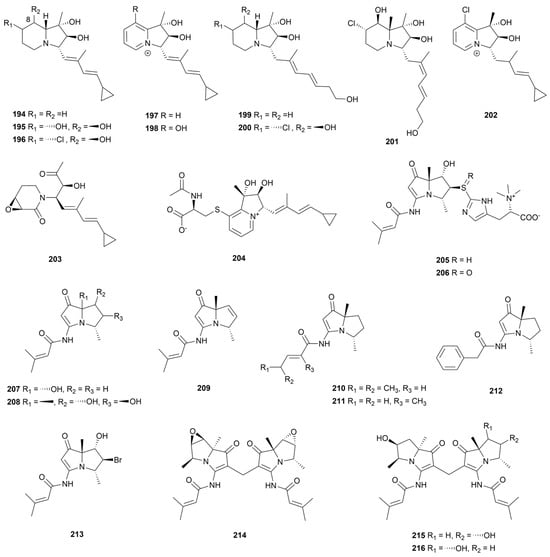
Figure 18. Chemical structures of indolizidine and pyrrolizidine alkaloids 194–216 isolated from marine Streptomyces.
8.2. Pyrrolizidines
Pyrrolizidines are mainly derived from plants as toxic components of chemical defense [114]. Bacterial-derived pyrrolizidines have been reported less frequently, with a total of 12 species and about 60 compounds of this class identified as of 2021 [115]. These Pyrrolizidines are commonly biosynthesized by multidomain NRPS gene clusters and are post-modified as well by flavine adenosine dinucleotide (FAD)-dependent monooxygenases [116].
Bohemamine is a rare pyrrolizidine subtype derived only from actinomycetes [117]. The fermentation broth of strain S. spinoverrucosus SNB-048 purified two bohemamine-type pyrrolizidines named spithioneines A and B (205 and 206, Figure 18) with rare ergothioneine moiety [118]. In the same year, six derivatives of bohemamines D−I (207–212, Figure 18) were again isolated from strain SNB-048 [119]. Unfortunately, none of the compounds showed significant activity. Tracing the cytotoxic activity of S. spinoverrucosus SNB-032 metabolites led to the isolation of an analogue, 5-Br-bohemamine C (213, Figure 18), as well as three dimeric bohemamines dibohemamines A–C (214–216, Figure 18) [120]. The authors confirmed that the dimer formation was a non-enzymatic Baylis–Hillman addition reaction of monomeric compounds using formaldehyde in the medium. Compounds 215 and 216 exhibited potent cytotoxicity against an NSCLC cell line A549 with IC50 values of 0.140 and 0.145 µM, respectively. In addition, compound 216 showed moderate activity against an HCC1171 cell line (IC50 = 1.2 µM). Bohemamine-type pyrrolizidines exhibited significant cytotoxic activity due to the polymerization of dimer.
9. Amides
9.1. Linear Amides
Marine sediment-derived Streptomyces sp. SNE-011 afforded three acylated arylamine alkaloids named carpatamides A–C (217–219, Figure 19) [121]. Compounds 217 and 219 displayed positive activity against HCC366, A549 and HCC44 cell lines (IC50 = 2.2–8.4 μM). For compound 218, the authors hypothesized that the reason for its inactivity was the inability of the structure to pass through the cell membrane. Antimycin is an antibiotic with antibacterial, insecticidal and anticancer activity, consisting of a rare nine-membered dilactone core [122]. Antimycins E–H (220–223, Figure 19) were isolated from Streptomyces sp. THS-55, and showed extremely significant cytotoxic activity against the HeLa cell line (IC50 < 0.1 μM) by downregulating the levels of E6/E7 oncoproteins [123]. The potency was dependent on the long-chain substituent of R2 and the acyl group of R3. In addition, neoantimycins A and B (224 and 225, Figure 19) were isolated from S. antibioticus and exhibited weak cytotoxic activity against the SF-268 cancer cell line [124]. Bagremycin is a phenol ester formed from p-hydroxystyrene and p-hydroxybenzoic acid with antimicrobial activity [125]. Bagremycins C and D (226 and 227, Figure 19) were isolated in 2017 from Streptomyces sp. Q22 [126]. The following year, bagremycins F and G (228 and 229, Figure 19) were purified from coastal mud-sourced Streptomyces sp. ZZ745 [127]. Compound 226 inhibited the G0/G1 cell cycle in four glioma cells (U87MG, U251, SHG44 and C6) with IC50 values of 2.2 to 6.4 μM. Furthermore, compounds 228 and 229 showed 41.8 and 67.1 μM MIC values against E. coli. One N-acetyl macrolide analogue N-acetylborrelidin B (230, Figure 19) was detected by a strain S. mutabilis MII with stronger activity against Staphylococcus warneri (18 mm zone of inhibition) [128].
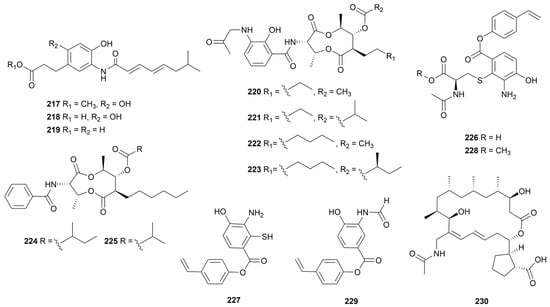
Figure 19. Chemical structures of linear amides 217–230 isolated from marine Streptomyces.
9.2. Macrolactams
Macrolactams are a class of macrocyclic compounds in which amide units are integrated into a polyketide skeleton above twelve carbons [129]. These compounds often contain an azacyclic core skeleton or azacyclic substituent modifications that result in alkalinity [130].
Polycyclic tetramate macrolactams (PTMs) are polycyclic macrolactam examples encoded by the PKS/NRPS heterozygous gene cluster [131]. Three PTMs (231–233, Figure 20) were purified from S. zhaozhouensis CA-185989 [132]. Compounds 231 and 232 had the most promising activity against MRSA, C. albicans and A. fumigatus (MIC = 1–8 μg/mL). The addition of the strong promoter ermE*p to the PTM gene cluster of the deep-sea-derived S. pactum SCSIO 02999 activated the generation of six antitumor active PTMs, pactamides A–F (234–239, Figure 20) [133]. Compound 234 exhibited 0.24–0.51 μM IC50 values against four cancer cell lines. In addition, some atypical structural PTMs (Figure 20) with moderate cytotoxic activity, such as chlorinated derivatives chlokamycin (240) and H-10/H-11 trans-oriented PTM (241–246), have been reported in recent years from marine Streptomyces metabolites [134][135]. The substituent class of the side-chain tricyclic ring significantly affected the biological activity of the compounds. Moreover, a simple macrolactam JBIR-150 (247, Figure 20) exhibited cytotoxic activity against human malignant mesothelioma MESO-1 (IC50 = 2.3 μM) and human T-lymphoma Jurkat cells (IC50 = 0.9 μM) [136]. Another similar substance, muanlactam (248, Figure 20) was targeted for purification from Streptomyces sp. MA159 through combined genomic library and spectral characterization; and its IC50 value against the HCT116 cell line was 1.58 μM [137]. Streptomyces sp. OUCMDZ-4348 is an extreme habitat microbe collected from Antarctica and was shown to produce two bicyclic macrolactams (249 and 250, Figure 20) [138]. Only 249 exhibited a moderate IC50 value (9.8 µM) against the gastric carcinoma cell line N87. In another polar actinomyces, S. somaliensis 1107, four macrocyclic lactam containing furan rings (251–254, Figure 20) were isolated, one of which, compound 251 had anti-inflammatory activity [139].
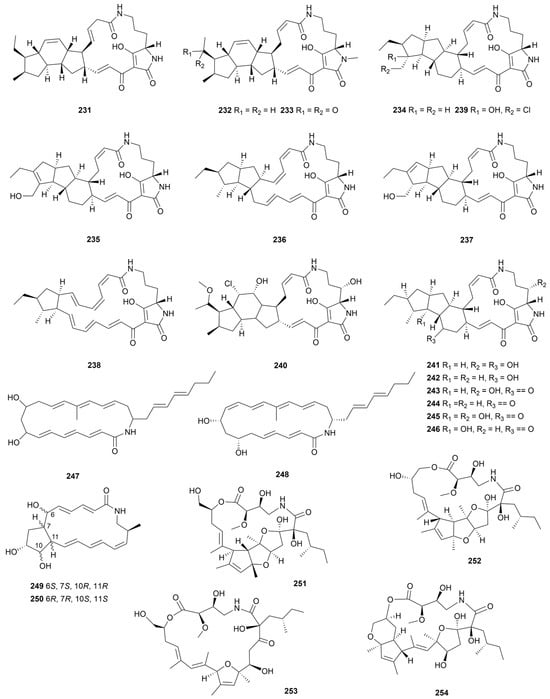
Figure 20. Chemical structures of macrolactams 231–254 isolated from marine Streptomyces.
10. Miscellaneous Alkaloids
Niphimycin (NM) is a class of guanidylpolyol macrolide antibiotics with extensive antibacterial activity against fungi and Gram-positive bacteria [140]. Four niphimycins derivatives (255–258, Figure 21) were obtained from Streptomyces sp. IMB7-145 and 255, 257 and 258 displayed antibacterial effects on MRSA and vancomycin-resistant enterococci (VRE) with MIC values of 8–64 μg/mL [141]. Moreover, compound 255 exhibited significant anti-M. tuberculosis activity (MIC = 32 μg/mL) and significantly inhibited the growth of the phytopathogenic fungus Fusarium oxysporum f. sp.cubense (EC50 = 1.20 μg/mL) as well as demonstrating cytotoxic activity against nasopharyngeal carcinoma cell lines TW03 and 5-8F (IC50 = 12.24 µg/mL and 9.44 µg/mL, respectively) [142][143]. The increase in malonyl substituents had a negative effect on its biological activity. Antartin (259, Figure 21) was a zizaane-type sesquiterpene produced by strain Streptomyces sp. SCO736 and showed promising cytotoxic activity against twelve human cancer cells, with 50% growth inhibition (GI50) of 4–8 µg/mL and inhibited the production of solid lung tumor cells [144]. Penzonemycins A and B (260–261, Figure 21) were two phenylhydrazones, in which their hydrazone moiety was synthesized by a non-enzymatic Japp−Klingemann coupling reaction [145]. Compound 260 inhibited cancer cell lines SF-268, MCF-7, A549 and HepG-2, with IC50 values ranging from 30.44 to 61.92 µM.
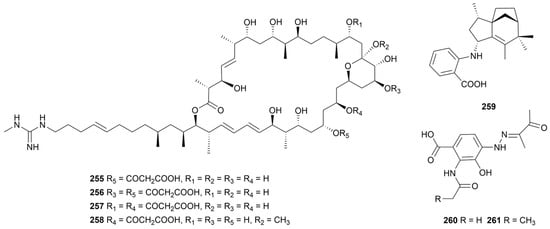
Figure 21. Chemical structures of miscellaneous alkaloids 255–261 isolated from marine Streptomyces.
References
- Konig, G.M.; Kehraus, S.; Seibert, S.F.; Abdel-Lateff, A.; Muller, D. Natural products from marine organisms and their associated microbes. Chembiochem 2006, 7, 229–238.
- Yang, Z.; He, J.; Wei, X.; Ju, J.; Ma, J. Exploration and genome mining of natural products from marine Streptomyces. Appl. Microbiol. Biotechnol. 2020, 104, 67–76.
- Hu, Y.; Chen, S.; Yang, F.; Dong, S. Marine indole alkaloids—Isolation, structure and bioactivities. Mar. Drugs 2021, 19, 658.
- Bérdy, J. Thoughts and facts about antibiotics: Where we are now and where we are heading. J. Antibiot. 2012, 65, 385–395.
- Fernandes, A.S.; Oliveira, C.; Reis, R.L.; Martins, A.; Silva, T.H. Marine-inspired drugs and biomaterials in the perspective of pancreatic cancer therapies. Mar. Drugs 2022, 20, 689.
- Barka, E.A.; Vatsa, P.; Sanchez, L.; Gaveau-Vaillant, N.; Jacquard, C.; Meier-Kolthoff, J.P.; Klenk, H.P.; Clement, C.; Ouhdouch, Y.; van Wezel, G.P. Taxonomy, physiology, and natural products of Actinobacteria. Microbiol. Mol. Biol. Rev. 2016, 80, 1–43.
- Ngamcharungchit, C.; Chaimusik, N.; Panbangred, W.; Euanorasetr, J.; Intra, B. Bioactive metabolites from terrestrial and marine actinomycetes. Molecules 2023, 28, 5915.
- Donald, L.; Pipite, A.; Subramani, R.; Owen, J.; Keyzers, R.A.; Taufa, T. Streptomyces: Still the biggest producer of new natural secondary metabolites, a current perspective. Microbiol. Res. 2022, 13, 418–465.
- Zhang, S.; Chen, Y.; Zhu, J.; Lu, Q.; Cryle, M.J.; Zhang, Y.; Yan, F. Structural diversity, biosynthesis, and biological functions of lipopeptides from Streptomyces. Nat. Prod. Rep. 2023, 40, 557–594.
- Huang, T.; Zhou, Z.; Liu, Q.; Wang, X.; Guo, W.; Lin, S. Biosynthetic mechanisms of alkaloids from actinomycetes. Prog. Chem. 2018, 30, 692–702.
- Netz, N.; Opatz, T. Marine indole alkaloids. Mar. Drugs 2015, 13, 4814–4914.
- Munekata, P.E.S.; Pateiro, M.; Conte-Junior, C.A.; Domínguez, R.; Nawaz, A.; Walayat, N.; Movilla Fierro, E.; Lorenzo, J.M. Marine alkaloids: Compounds with in vivo activity and chemical synthesis. Mar. Drugs 2021, 19, 374.
- Rosales, P.F.; Bordin, G.S.; Gower, A.E.; Moura, S. Indole alkaloids: 2012 until now, highlighting the new chemical structures and biological activities. Fitoterapia 2020, 143, 104558.
- Holland, D.C.; Carroll, A.R. Marine indole alkaloid diversity and bioactivity. What do we know and what are we missing? Nat. Prod. Rep. 2023, 40, 1595–1607.
- Xu, M.; Peng, R.; Min, Q.; Hui, S.; Chen, X.; Yang, G.; Qin, S. Bisindole natural products: A vital source for the development of new anticancer drugs. Eur. J. Med. Chem. 2022, 243, 114748.
- Carbone, D.; De Franco, M.; Pecoraro, C.; Bassani, D.; Pavan, M.; Cascioferro, S.; Parrino, B.; Cirrincione, G.; Dall’Acqua, S.; Moro, S.; et al. Discovery of the 3-amino-1,2,4-triazine-based library as selective PDK1 inhibitors with therapeutic potential in highly aggressive pancreatic ductal adenocarcinoma. Int. J. Mol. Sci. 2023, 24, 3679.
- Carbone, D.; De Franco, M.; Pecoraro, C.; Bassani, D.; Pavan, M.; Cascioferro, S.; Parrino, B.; Cirrincione, G.; Dall’Acqua, S.; Sut, S.; et al. Structural manipulations of marine natural products inspire a new library of 3-amino-1,2,4-triazine PDK inhibitors endowed with antitumor activity in pancreatic ductal adenocarcinoma. Mar. Drugs 2023, 21, 288.
- Gani, O.A.; Engh, R.A. Protein kinase inhibition of clinically important staurosporine analogues. Nat. Prod. Rep. 2010, 27, 489–498.
- Kapoor, R.; Saini, A.; Sharma, D. Indispensable role of microbes in anticancer drugs and discovery trends. Appl. Microbiol. Biotechnol. 2022, 106, 4885–4906.
- Cheng, X.; Zhou, B.; Liu, H.; Huo, C.; Ding, W. One new indolocarbazole alkaloid from the Streptomyces sp. A22. Nat. Prod. Res. 2018, 32, 2583–2588.
- Wang, J.N.; Zhang, H.J.; Li, J.Q.; Ding, W.J.; Ma, Z.J. Bioactive indolocarbazoles from the marine-derived Streptomyces sp. DT-A61. J. Nat. Prod. 2018, 81, 949–956.
- Onaka, H.; Asamizu, S.; Igarashi, Y.; Yoshida, R.; Furumai, T. Cytochrome P450 homolog is responsible for C-N bond formation between aglycone and deoxysugar in the staurosporine biosynthesis of Streptomyces sp. TP-A0274. Biosci. Biotechnol. Biochem. 2005, 69, 1753–1759.
- Qin, L.; Zhou, B.; Ding, W.; Ma, Z. Bioactive metabolites from marine-derived Streptomyces sp. A68 and its Rifampicin resistant mutant strain R-M1. Phytochem. Lett. 2018, 23, 46–51.
- Zhou, B.; Hu, Z.J.; Zhang, H.J.; Li, J.Q.; Ding, W.J.; Ma, Z.J. Bioactive staurosporine derivatives from the Streptomyces sp. NB-A13. Bioorg. Chem. 2019, 82, 33–40.
- Zhou, B.; Qin, L.; Ding, W.; Ma, Z. Cytotoxic indolocarbazoles alkaloids from the Streptomyces sp. A65. Tetrahedron 2018, 74, 726–730.
- Wang, C.; Monger, A.; Wang, L.; Fu, P.; Piyachaturawat, P.; Chairoungdua, A.; Zhu, W. Precursor-directed generation of indolocarbazoles with topoisomerase IIα inhibitory activity. Mar. Drugs 2018, 16, 168.
- Cui, T.; Lin, S.; Wang, Z.; Fu, P.; Wang, C.; Zhu, W. Cytotoxic indolocarbazoles from a marine-derived Streptomyces sp. OUCMDZ-5380. Front. Microbiol. 2022, 13, 957473.
- Zhang, W.; Ma, L.; Li, S.; Liu, Z.; Chen, Y.; Zhang, H.; Zhang, G.; Zhang, Q.; Tian, X.; Yuan, C.; et al. Indimicins A–E, bisindole alkaloids from the deep-sea-derived Streptomyces sp. SCSIO 03032. J. Nat. Prod. 2014, 77, 1887–1892.
- Liu, Z.; Ma, L.; Zhang, L.; Zhang, W.; Zhu, Y.; Chen, Y.; Zhang, W.; Zhang, C. Functional characterization of the halogenase SpmH and discovery of new deschloro-tryptophan dimers. Org. Biomol. Chem. 2019, 17, 1053–1057.
- Paulus, C.; Rebets, Y.; Tokovenko, B.; Nadmid, S.; Terekhova, L.P.; Myronovskyi, M.; Zotchev, S.B.; Ruckert, C.; Braig, S.; Zahler, S.; et al. New natural products identified by combined genomics-metabolomics profiling of marine Streptomyces sp. MP131-18. Sci. Rep. 2017, 7, 42382.
- Song, Y.; Yang, J.; Yu, J.; Li, J.; Yuan, J.; Wong, N.K.; Ju, J. Chlorinated bis-indole alkaloids from deep-sea derived Streptomyces sp. SCSIO 11791 with antibacterial and cytotoxic activities. J. Antibiot. 2020, 73, 542–547.
- Ding, L.; Munch, J.; Goerls, H.; Maier, A.; Fiebig, H.H.; Lin, W.H.; Hertweck, C. Xiamycin, a pentacyclic indolosesquiterpene with selective anti-HIV activity from a bacterial mangrove endophyte. Bioorg. Med. Chem. Lett. 2010, 20, 6685–6687.
- Munda, M.; Nandi, R.; Gavit, V.R.; Kundu, S.; Niyogi, S.; Bisai, A. Total syntheses of naturally occurring antiviral indolosesquiterpene alkaloids, xiamycins C-F via Csp(3)-H functionalization. Chem. Sci. 2022, 13, 11666–11671.
- Kim, S.H.; Ha, T.K.; Oh, W.K.; Shin, J.; Oh, D.C. Antiviral indolosesquiterpenoid xiamycins C-E from a halophilic actinomycete. J. Nat. Prod. 2016, 79, 51–58.
- Park, J.; Cho, H.S.; Moon, D.H.; Lee, D.; Kal, Y.; Cha, S.; Lee, S.K.; Yoon, Y.J.; Oh, D.-C. Discovery of new indolosesquiterpenoids bearing a N-O linkage by overexpression of LuxR regulator in a marine bacterium Streptomyces sp. Front. Mar. Sci. 2023, 10, 1140516.
- Zhang, S.; Yang, Q.; Guo, L.; Zhang, Y.; Feng, L.; Zhou, L.; Yang, S.; Yao, Q.; Pescitelli, G.; Xie, Z. Isolation, structure elucidation and racemization of (+)- and (−)-pratensilins A-C: Unprecedented spiro indolinone-naphthofuran alkaloids from a marine Streptomyces sp. Chem. Commun. 2017, 53, 10066–10069.
- Guo, L.; Zhang, L.; Yang, Q.; Xu, B.; Fu, X.; Liu, M.; Li, Z.; Zhang, S.; Xie, Z. Antibacterial and cytotoxic bridged and ring cleavage angucyclinones from a marine Streptomyces sp. Front. Chem. 2020, 8, 586.
- Che, Q.; Qiao, L.; Han, X.; Liu, Y.; Wang, W.; Gu, Q.; Zhu, T.; Li, D. Anthranosides A-C, anthranilate derivatives from a sponge-derived Streptomyces sp. CMN-62. Org. Lett. 2018, 20, 5466–5469.
- Newaz, A.W.; Yong, K.; Lian, X.; Zhang, Z. Streptoindoles A–D, novel antimicrobial indole alkaloids from the marine-associated actinomycete Streptomyces sp. ZZ1118. Tetrahedron 2022, 104, 132598.
- Zhang, Y.; Hou, S.; Zhang, M.; Wu, Y. Research progress in biosynthesis of five-membered heterocyclic rings in natural products. J. Microbiol. 2019, 39, 1–12.
- Seipp, K.; Geske, L.; Opatz, T. Marine pyrrole alkaloids. Mar. Drugs 2021, 19, 514.
- Asif, M.; Alghamdi, S. An overview on biological importance of pyrrolone and pyrrolidinone derivatives as promising Sscaffolds. Russ. J. Org. Chem. 2021, 57, 1700–1718.
- Mo, X.; Wang, Z.; Wang, B.; Ma, J.; Huang, H.; Tian, X.; Zhang, S.; Zhang, C.; Ju, J. Cloning and characterization of the biosynthetic gene cluster of the bacterial RNA polymerase inhibitor tirandamycin from marine-derived Streptomyces sp. SCSIO1666. Biochem. Biophys. Res. Commun. 2011, 406, 341–347.
- Zhang, X.; Li, Z.; Du, L.; Chlipala, G.E.; Lopez, P.C.; Zhang, W.; Sherman, D.H.; Li, S. Identification of an unexpected shunt pathway product provides new insights into tirandamycin biosynthesis. Tetrahedron Lett. 2016, 57, 5919–5923.
- Cong, Z.; Huang, X.; Liu, Y.; Liu, Y.; Wang, P.; Liao, S.; Yang, B.; Zhou, X.; Huang, D.; Wang, J. Cytotoxic anthracycline and antibacterial tirandamycin analogues from a marine-derived Streptomyces sp. SCSIO 41399. J. Antibiot. 2019, 72, 45–49.
- Song, F.; Hu, J.; Zhang, X.; Xu, W.; Yang, J.; Li, S.; Xu, X. Unique cyclized thiolopyrrolones from the marine-derived Streptomyces sp. BTBU20218885. Mar. Drugs 2022, 20, 214.
- Chung, B.; Hwang, J.Y.; Park, S.C.; Kwon, O.S.; Cho, E.; Lee, J.; Lee, H.S.; Oh, D.C.; Shin, J.; Oh, K.B. Inhibitory effects of nitrogenous metabolites from a marine-derived Streptomyces bacillaris on isocitrate lyase of Candida albicans. Mar. Drugs 2022, 20, 138.
- Kim, M.C.; Lee, J.H.; Shin, B.; Subedi, L.; Cha, J.W.; Park, J.S.; Oh, D.C.; Kim, S.Y.; Kwon, H.C. Salinazinones A and B: Pyrrolidinyl-oxazinones from solar saltern-derived Streptomyces sp. KMF-004. Org. Lett. 2015, 17, 5024–5027.
- Zhang, Y.M.; Liu, B.L.; Zheng, X.H.; Huang, X.J.; Li, H.Y.; Zhang, Y.; Zhang, T.T.; Sun, D.Y.; Lin, B.R.; Zhou, G.X. Anandins A and B, two rare steroidal alkaloids from a marine Streptomyces anandii H41-59. Mar. Drugs 2017, 15, 355.
- Lim, H.J.; An, J.S.; Bae, E.S.; Cho, E.; Hwang, S.; Nam, S.J.; Oh, K.B.; Lee, S.K.; Oh, D.C. Ligiamycins A and B, decalin-amino-maleimides from the co-culture of Streptomyces sp. and Achromobacter sp. Isolated from the marine wharf roach, Ligia exotica. Mar. Drugs 2022, 20, 83.
- Varvounis, G. An update on the synthesis of pyrrolobenzodiazepines. Molecules 2016, 21, 154.
- Pavlikova, M.; Kamenik, Z.; Janata, J.; Kadlcik, S.; Kuzma, M.; Najmanova, L. Novel pathway of 3-hydroxyanthranilic acid formation in limazepine biosynthesis reveals evolutionary relation between phenazines and pyrrolobenzodiazepines. Sci. Rep. 2018, 8, 7810.
- Han, Y.; Li, Y.Y.; Shen, Y.; Li, J.; Li, W.J.; Shen, Y.M. Oxoprothracarcin, a novel pyrrolobenzodiazepine antibiotic from marine Streptomyces sp. M10946. Drug Discov. Ther. 2013, 7, 243–247.
- Çetinel Aksoy, S.; Küçüksolak, M.; Uze, A.; Bedir, E. Benzodiazepine derivatives from marine-derived Streptomyces cacaoi 14CM034. Rec. Nat. Prod. 2021, 15, 602–607.
- Kang, Q.; Shen, Y.; Bai, L. Biosynthesis of 3,5-AHBA-derived natural products. Nat. Prod. Rep. 2012, 29, 243–263.
- Li, S.; Wang, H.; Li, Y.; Deng, J.; Lu, C.; Shen, Y.; Shen, Y. Biosynthesis of hygrocins, antitumor naphthoquinone ansamycins produced by Streptomyces sp. LZ35. Chembiochem 2014, 15, 94–102.
- Cai, P.; Kong, F.; Ruppen, M.E.; Glasier, G. Hygrocins A and B, naphthoquinone macrolides from Streptomyces hygroscopicus. J. Nat. Prod. 2005, 68, 1736–1742.
- Lu, C.; Li, Y.; Deng, J.; Li, S.; Shen, Y.; Wang, H.; Shen, Y. Hygrocins C-G, cytotoxic naphthoquinone ansamycins from gdmAI-disrupted Streptomyces sp. LZ35. J. Nat. Prod. 2013, 76, 2175–2179.
- Li, S.; Lu, C.; Ou, J.; Deng, J.; Shen, Y. Overexpression of hgc1 increases the production and diversity of hygrocins in Streptomyces sp. LZ35. RSC Adv. 2015, 5, 83843–83846.
- Yi, W.; Newaz, A.W.; Yong, K.; Ma, M.; Lian, X.Y.; Zhang, Z. New Hygrocins K-U and streptophenylpropanamide A and bioactive compounds from the marine-associated Streptomyces sp. ZZ1956. Antibiotics 2022, 11, 1455.
- Le, T.C.; Yang, I.; Yoon, Y.J.; Nam, S.J.; Fenical, W. Ansalactams B-D illustrate further biosynthetic plasticity within the ansamycin pathway. Org. Lett. 2016, 18, 2256–2259.
- Zhou, L.M.; Kong, F.D.; Xie, Q.Y.; Ma, Q.Y.; Hu, Z.; Zhao, Y.X.; Luo, D.Q. Divergolides T-W with apoptosis-inducing activity from the mangrove-derived actinomycete Streptomyces sp. KFD18. Mar. Drugs 2019, 17, 219.
- Alvarez-Mico, X.; Jensen, P.R.; Fenical, W.; Hughes, C.C. Chlorizidine, a cytotoxic 5H-pyrroloisoindol-5-one-containing alkaloid from a marine Streptomyces sp. Org. Lett. 2013, 15, 988–991.
- Heo, C.S.; Kang, J.S.; Kwon, J.H.; Anh, C.V.; Shin, H.J. Pyrrole-containing alkaloids from a marine-derived actinobacterium Streptomyces zhaozhouensis and their antimicrobial and cytotoxic activities. Mar. Drugs 2023, 21, 167.
- Lian, X.Y.; Zhang, Z. Indanomycin-related antibiotics from marine Streptomyces antibioticus PTZ0016. Nat. Prod. Res. 2013, 27, 2161–2167.
- Zhou, B.; Huang, Y.; Zhang, H.; Li, J.; Ding, W. Nitricquinomycins A-C, uncommon naphthopyrrolediones from the Streptomyces sp. ZS-A45. Tetrahedron 2019, 75, 3958–3961.
- Song, F.; Yang, N.; Khalil, Z.G.; Salim, A.A.; Han, J.; Bernhardt, P.V.; Lin, R.; Xu, X.; Capon, R.J. Bhimamycin J, a rare benzoisoindole-dione alkaloid from the marine-derived actinomycete Streptomyces sp. MS180069. Chem. Biodivers. 2021, 18, e2100674.
- Ko, K.; Kim, S.H.; Park, S.; Han, H.S.; Lee, J.K.; Cha, J.W.; Hwang, S.; Choi, K.Y.; Song, Y.J.; Nam, S.J.; et al. Discovery and photoisomerization of new pyrrolosesquiterpenoids glaciapyrroles D and E, from deep-sea sediment Streptomyces sp. Mar. Drugs 2022, 20, 281.
- Guerrero-Pepinosa, N.Y.; Cardona-Trujillo, M.C.; Garzon-Castano, S.C.; Veloza, L.A.; Sepulveda-Arias, J.C. Antiproliferative activity of thiazole and oxazole derivatives: A systematic review of in vitro and in vivo studies. Biomed. Pharmacother. 2021, 138, 111495.
- Davyt, D.; Serra, G. Thiazole and oxazole alkaloids: Isolation and synthesis. Mar. Drugs 2010, 8, 2755–2780.
- Liu, Y.; Ding, L.; Deng, Y.; Wang, X.; Cui, W.; He, S. Feature-based molecular networking-guided discovery of siderophores from a marine mesophotic zone Axinellida sponge-associated actinomycete Streptomyces diastaticus NBU2966. Phytochemistry 2022, 196, 113078.
- Zhou, X.; Fenical, W. The unique chemistry and biology of the piericidins. J. Antibiot. 2016, 69, 582–593.
- Azad, S.M.; Jin, Y.; Ser, H.-L.; Goh, B.-H.; Thawai, L.-H.I.C.; He, Y.-W. Biological insights into the piericidin family of microbial metabolites. J. Appl. Microbiol. 2022, 132, 772–784.
- Zhou, X.; Liang, Z.; Li, K.; Fang, W.; Tian, Y.; Luo, X.; Chen, Y.; Zhan, Z.; Zhang, T.; Liao, S.; et al. Exploring the natural piericidins as anti-renal cell carcinoma agents targeting peroxiredoxin 1. J. Med. Chem. 2019, 62, 7058–7069.
- Peng, J.; Zhang, Q.; Jiang, X.; Ma, L.; Long, T.; Cheng, Z.; Zhang, C.; Zhu, Y. New piericidin derivatives from the marine-derived Streptomyces sp. SCSIO 40063 with cytotoxic activity. Nat. Prod. Res. 2022, 36, 2458–2464.
- Heeb, S.; Fletcher, M.P.; Chhabra, S.R.; Diggle, S.P.; Williams, P.; Camara, M. Quinolones: From antibiotics to autoinducers. FEMS Microbiol. Rev. 2011, 35, 247–274.
- Senerovic, L.; Opsenica, D.; Moric, I.; Aleksic, I.; Spasic, M.; Vasiljevic, B. Quinolines and quinolones as antibacterial, antifungal, anti-virulence, antiviral and anti-parasitic agents. Adv. Exp. Med. Biol. 2020, 1282, 37–69.
- Hassan, H.M.; Boonlarppradab, C.; Fenical, W. Actinoquinolines A and B, anti-inflammatory quinoline alkaloids from a marine-derived Streptomyces sp., strain CNP975. J. Antibiot. 2016, 69, 511–514.
- Ortiz-Lopez, F.J.; Alcalde, E.; Sarmiento-Vizcaino, A.; Diaz, C.; Cautain, B.; Garcia, L.A.; Blanco, G.; Reyes, F. New 3-hydroxyquinaldic acid derivatives from cultures of the marine derived actinomycete Streptomyces cyaneofuscatus M-157. Mar. Drugs 2018, 16, 371.
- Mullowney, M.W.; Ó hAinmhire, E.; Shaikh, A.; Wei, X.; Tanouye, U.; Santarsiero, B.D.; Burdette, J.E.; Murphy, B.T. Diazaquinomycins E-G, novel diaza-anthracene analogs from a marine-derived Streptomyces sp. Mar. Drugs 2014, 12, 3574–3586.
- Cheng, C.; Othman, E.M.; Reimer, A.; Grüne, M.; Kozjak-Pavlovic, V.; Stopper, H.; Hentschel, U.; Abdelmohsen, U.R. Ageloline A, new antioxidant and antichlamydial quinolone from the marine sponge-derived bacterium Streptomyces sp. SBT345. Tetrahedron Lett. 2016, 57, 2786–2789.
- Shaaban, M.; Shaaban, K.A.; Kelter, G.; Fiebig, H.H.; Laatsch, H. Mansouramycins E–G, cytotoxic isoquinolinequinones from marine Streptomycetes. Mar. Drugs 2021, 19, 715.
- Yang, C.L.; Wang, Y.S.; Liu, C.L.; Zeng, Y.J.; Cheng, P.; Jiao, R.H.; Bao, S.X.; Huang, H.Q.; Tan, R.X.; Ge, H.M. Strepchazolins A and B: Two new alkaloids from a marine Streptomyces chartreusis NA02069. Mar. Drugs 2017, 15, 244.
- Zhang, D.; Yi, W.; Ge, H.; Zhang, Z.; Wu, B. Bioactive streptoglutarimides A-J from the marine-derived Streptomyces sp. ZZ741. J. Nat. Prod. 2019, 82, 2800–2808.
- Hou, W.; Dai, W.; Huang, H.; Liu, S.-L.; Liu, J.; Huang, L.-J.; Huang, X.-H.; Zeng, J.-L.; Gan, Z.-W.; Zhang, Z.-Y.; et al. Pharmacological activity and mechanism of pyrazines. Eur. J. Med. Chem. 2023, 258, 115544.
- Dolezal, M.; Zitko, J. Pyrazine derivatives: A patent review (June 2012-present). Expert Opin. Ther. Pat. 2015, 25, 33–47.
- Lee, D.S.; Yoon, C.S.; Jung, Y.T.; Yoon, J.H.; Kim, Y.C.; Oh, H. Marine-derived secondary metabolite, griseusrazin A, suppresses inflammation through heme oxygenase-1 induction in activated RAW264.7 macrophages. J. Nat. Prod. 2016, 79, 1105–1111.
- Shaala, L.A.; Youssef, D.T.; Badr, J.M.; Harakeh, S.M. Bioactive 2(1H)-pyrazinones and diketopiperazine alkaloids from a tunicate-derived actinomycete Streptomyces sp. Molecules 2016, 21, 1116.
- Chen, M.; Chai, W.; Zhu, R.; Song, T.; Zhang, Z.; Lian, X. Streptopyrazinones A-D, rare metabolites from marine-derived Streptomyces sp. ZZ446. Tetrahedron 2018, 74, 2100–2106.
- Kim, S.; Hillman, P.F.; Lee, J.Y.; Lee, J.; Lee, J.; Cha, S.-S.; Oh, D.-C.; Nam, S.-J.; Fenical, W. Actinopolymorphols E and F, pyrazine alkaloids from a marine sediment-derived bacterium Streptomyces sp. J. Antibiot. 2022, 75, 619–625.
- Sano, S.; Nakao, M. Chemistry of 2,5-diketopiperazine and its bis-lactim ether: A brief review. Heterocycles 2015, 91, 1349.
- Borthwick, A.D. 2,5-Diketopiperazines: Synthesis, reactions, medicinal chemistry, and bioactive natural products. Chem. Rev. 2012, 112, 3641–3716.
- Ou, Y.X.; Huang, J.F.; Li, X.M.; Kang, Q.J.; Pan, Y.T. Three new 2,5-diketopiperazines from the fish intestinal Streptomyces sp. MNU FJ-36. Nat. Prod. Res. 2016, 30, 1771–1775.
- Yi, W.; Qin, L.; Lian, X.Y.; Zhang, Z. New antifungal metabolites from the Mariana Trench sediment-associated actinomycete Streptomyces sp. SY1965. Mar. Drugs 2020, 18, 385.
- Buedenbender, L.; Grkovic, T.; Duffy, S.; Kurtböke, D.I.; Avery, V.M.; Carroll, A.R. Naseseazine C, a new anti-plasmodial dimeric diketopiperazine from a marine sediment derived Streptomyces sp. Tetrahedron Lett. 2016, 57, 5893–5895.
- Shaala, L.A.; Youssef, D.T.A.; Badr, J.M.; Harakeh, S.M.; Genta-Jouve, G. Bioactive diketopiperazines and nucleoside derivatives from a sponge-derived Streptomyces species. Mar. Drugs 2019, 17, 584.
- Chen, S.; Zhang, D.; Chen, M.; Zhang, Z.; Lian, X.Y. A rare diketopiperazine glycoside from marine-sourced Streptomyces sp. ZZ446. Nat. Prod. Res. 2020, 34, 1046–1050.
- Olyaei, A.; Sadeghpour, M. A review on lawsone-based benzophenazin-5-ol: Synthetic approaches and reactions. RSC Adv. 2022, 12, 13837–13895.
- Remali, J.; Mohamad Zin, N.; Ng, C.L.; Wan, M.; Aizat, W.M.A.; Tiong, J.J.L. Fenazin sebagai potensi antibiotik baru daripada Streptomyces kebangsaanensis. Sains Malays. 2019, 48, 543–553.
- Ren, J.; Liu, D.; Tian, L.; Wei, Y.; Proksch, P.; Zeng, J.; Lin, W. Venezuelines A-G, new phenoxazine-based alkaloids and aminophenols from Streptomyces venezuelae and the regulation of gene target Nur77. Bioorg. Med. Chem. Lett. 2013, 23, 301–304.
- Abdelfattah, M.S. A new bioactive aminophenoxazinone alkaloid from a marine-derived actinomycete. Nat. Prod. Res. 2013, 27, 2126–2131.
- Dharmaraj, S.; Sumantha, A. Bioactive potential of Streptomyces associated with marine sponges. World J. Microbiol. Biotechnol. 2009, 25, 1971–1979.
- Kunz, A.L.; Labes, A.; Wiese, J.; Bruhn, T.; Bringmann, G.; Imhoff, J.F. Nature’s lab for derivatization: New and revised structures of a variety of streptophenazines produced by a sponge-derived Streptomyces strain. Mar. Drugs 2014, 12, 1699–1714.
- Cheng, C.; Othman, E.M.; Fekete, A.; Krischke, M. Strepoxazine A, a new cytotoxic phenoxazin from the marine sponge-derived bacterium Streptomyces sp. SBT345. Tetrahedron Lett. 2016, 57, 4196–4199.
- Wang, Q.; Zhang, Y.; Wang, M.; Tan, Y.; Hu, X.; He, H.; Xiao, C.; You, X.; Wang, Y.; Gan, M. Neo-actinomycins A and B, natural actinomycins bearing the 5H-oxazolophenoxazine chromophore, from the marine-derived Streptomyces sp. IMB094. Sci. Rep. 2017, 7, 3591.
- Zhao, W.; Wang, G.; Guo, L.; Wang, J.; Jing, C.; Liu, B.; Zhao, F.; Zhang, S.; Xie, Z. Asp-containing actinomycin and tetracyclic chromophoric analogues from the Streptomyces sp. strain S22. Org. Biomol. Chem. 2023, 21, 1737–1743.
- Zhang, J.; Morris-Natschke, S.L.; Ma, D.; Shang, X.F.; Yang, C.J.; Liu, Y.-Q.; Lee, K.-H. Biologically active indolizidine alkaloids. Med. Res. Rev. 2020, 41, 928–960.
- Michael, J.P. Indolizidine and quinolizidine alkaloids. Nat. Prod. Rep. 2002, 19, 719–741.
- Jiang, Y.-J.; Li, J.-Q.; Zhang, H.-J.; Ding, W.-J.; Ma, Z.-J. Cyclizidine-type alkaloids from Streptomyces sp. HNA39. J. Nat. Prod. 2018, 81, 394–399.
- Cheng, X.W.; Li, J.Q.; Jiang, Y.J.; Liu, H.Z.; Huo, C. A new indolizinium alkaloid from marine-derived Streptomyces sp. HNA39. J. Asian Nat. Prod. Res. 2021, 23, 913–918.
- Jiang, W.; Zhong, Y.; Shen, L.; Wu, X.; Ye, Y.; Chen, C.-T.A.; Wu, B. Stress-driven discovery of natural products from extreme marine environment- Kueishantao hydrothermal vent, a case study of Metal Switch Valve. Curr. Org. Chem. 2014, 18, 925–934.
- Shi, Y.; Pan, C.; Auckloo, B.N.; Chen, X.; Chen, C.A.; Wang, K.; Wu, X.; Ye, Y.; Wu, B. Stress-driven discovery of a cryptic antibiotic produced by Streptomyces sp. WU20 from Kueishantao hydrothermal vent with an integrated metabolomics strategy. Appl. Microbiol. Biotechnol. 2017, 101, 1395–1408.
- Zhang, X.; Chen, L.; Chai, W.; Lian, X.-Y.; Zhang, Z. A unique indolizinium alkaloid streptopertusacin A and bioactive bafilomycins from marine-derived Streptomyces sp. HZP-2216E. Phytochemistry 2017, 144, 119–126.
- Fang, Q.; Wu, L.; Urwald, C.; Mugat, M.; Wang, S.; Kyeremeh, K.; Philips, C.; Law, S.; Zhou, Y.; Deng, H. Genomic scanning enabling discovery of a new antibacterial bicyclic carbamate-containing alkaloid. Synth. Syst. Biotechnol. 2021, 6, 12–19.
- Li, S.; Duan, Y.; Huang, Y. Discovery and biosynthesis of bacterial pyrrolizidine alkaloids. Microbiol. China 2021, 48, 2437–2453.
- Huang, S.; Tabudravu, J.; Elsayed, S.S.; Travert, J.; Peace, D.; Tong, M.H.; Kyeremeh, K.; Kelly, S.M.; Trembleau, L.; Ebel, R.; et al. Discovery of a single monooxygenase that catalyzes carbamate formation and ring contraction in the biosynthesis of the legonmycins. Angew. Chem. Int. Ed. Engl. 2015, 54, 12697–12701.
- Bugni, T.S.; Woolery, M.; Kauffman, C.A.; Jensen, P.R.; Fenical, W. Bohemamines from a marine-derived Streptomyces sp. J. Nat. Prod. 2006, 69, 1626–1628.
- Fu, P.; MacMillan, J.B. Spithioneines A and B, two new bohemamine derivatives possessing ergothioneine moiety from a marine-derived Streptomyces spinoverrucosus. Org. Lett. 2015, 17, 3046–3049.
- Fu, P.; La, S.; MacMillan, J.B. 1,3-oxazin-6-one derivatives and bohemamine-type pyrrolizidine alkaloids from a marine-derived Streptomyces spinoverrucosus. J. Nat. Prod. 2016, 79, 455–462.
- Fu, P.; Legako, A.; La, S.; MacMillan, J.B. Discovery, Characterization, and Analogue Synthesis of Bohemamine Dimers Generated by Non-enzymatic Biosynthesis. Chemistry 2016, 22, 3491–3495.
- Fu, P.; Johnson, M.; Chen, H.; Posner, B.A.; MacMillan, J.B. Carpatamides A-C, cytotoxic arylamine derivatives from a marine-derived Streptomyces sp. J. Nat. Prod. 2014, 77, 1245–1248.
- Yan, Y.; Zhang, L.; Ito, T.; Qu, X.; Asakawa, Y.; Awakawa, T.; Abe, I.; Liu, W. Biosynthetic pathway for high structural diversity of a common dilactone core in antimycin production. Org. Lett. 2012, 14, 4142–4145.
- Zhang, W.; Che, Q.; Tan, H.; Qi, X.; Li, J.; Li, D.; Gu, Q.; Zhu, T.; Liu, M. Marine Streptomyces sp. derived antimycin analogues suppress HeLa cells via depletion HPV E6/E7 mediated by ROS-dependent ubiquitin-proteasome system. Sci. Rep. 2017, 7, 42180.
- Hu, C.; Zhou, S.W.; Chen, F.; Zheng, X.H.; Shen, H.F.; Lin, B.R.; Zhou, G.X. Neoantimycins A and B, two unusual benzamido nine-membered dilactones from marine-derived Streptomyces antibioticus H12-15. Molecules 2017, 22, 557.
- Bertasso, M.; Holzenkämpfer, M.; Zeeck, A.; Dall’Antonia, F. Bagremycin A and B, novel antibiotics from Streptomyces sp. Tü 4128. J. Antibiot. 2001, 54, 730–736.
- Chen, L.; Chai, W.; Wang, W.; Song, T.; Lian, X.Y.; Zhang, Z. Cytotoxic bagremycins from mangrove-derived Streptomyces sp. Q22. J. Nat. Prod. 2017, 80, 1450–1456.
- Zhang, D.; Shu, C.; Lian, X.; Zhang, Z. New antibacterial bagremycins F and G from the marine-derived Streptomyces sp. ZZ745. Mar. Drugs 2018, 16, 330.
- Hamed, A.; Abdel-Razek, A.S.; Frese, M.; Wibberg, D.; El-Haddad, A.F.; Ibrahim, T.M.A.; Kalinowski, J.; Sewald, N.; Shaaban, M. N-Acetylborrelidin B: A new bioactive metabolite from Streptomyces mutabilis sp. MII. Z. Naturforsch. C 2018, 73, 49–57.
- Miyanaga, A.; Kudo, F.; Eguchi, T. Mechanisms of beta-amino acid incorporation in polyketide macrolactam biosynthesis. Curr. Opin. Chem. Biol. 2016, 35, 58–64.
- Hugel, H.M.; Smith, A.T.; Rizzacasa, M.A. Macrolactam analogues of macrolide natural products. Org. Biomol. Chem. 2016, 14, 11301–11316.
- Antosch, J.; Schaefers, F.; Gulder, T.A. Heterologous reconstitution of ikarugamycin biosynthesis in E. coli. Angew. Chem. Int. Ed. Engl. 2014, 53, 3011–3014.
- Lacret, R.; Oves-Costales, D.; Gómez, C.; Díaz, C.; de la Cruz, M.; Pérez-Victoria, I.; Vicente, F.; Genilloud, O.; Reyes, F. New ikarugamycin derivatives with antifungal and antibacterial properties from Streptomyces zhaozhouensis. Mar. Drugs 2014, 13, 128–140.
- Saha, S.; Zhang, W.; Zhang, G.; Zhu, Y.; Chen, Y.; Liu, W.; Yuan, C.; Zhang, Q.; Zhang, H.; Zhang, L.; et al. Activation and characterization of a cryptic gene cluster reveals a cyclization cascade for polycyclic tetramate macrolactams. Chem. Sci. 2017, 8, 1607–1612.
- Fukudaa, T.; Takahashia, M.; Kasaib, H.; Nagaia, K.; Tomodaa, H. Chlokamycin, a new chloride from the marine-derived Streptomyces sp. MA2-12. Nat. Prod. Commun. 2017, 12, 1223–1226.
- Liu, W.; Zhang, W.; Jin, H.; Zhang, Q.; Chen, Y.; Jiang, X.; Zhang, G.; Zhang, L.; Zhang, W.; She, Z.; et al. Genome mining of marine-derived Streptomyces sp. SCSIO 40010 leads to cytotoxic new polycyclic tetramate macrolactams. Mar. Drugs 2019, 17, 663.
- Kawahara, T.; Fujiwara, T.; Kagaya, N.; Shin-Ya, K. JBIR-150, a novel 20-membered polyene macrolactam from marine-derived Streptomyces sp. OPMA00071. J. Antibiot. 2018, 71, 390–392.
- Shin, Y.H.; Im, J.H.; Kang, I.; Kim, E.; Jang, S.C.; Cho, E.; Shin, D.; Hwang, S.; Du, Y.E.; Huynh, T.H.; et al. Genomic and spectroscopic signature-based discovery of natural macrolactams. J. Am. Chem. Soc. 2023, 145, 1886–1896.
- Shen, J.; Wang, J.; Chen, H.; Wang, Y.; Zhu, W.; Fu, P. Cyclamenols E and F, two diastereoisomeric bicyclic macrolactams with a cyclopentane moiety from an Antarctic Streptomyces species. Org. Chem. Front. 2020, 7, 310–317.
- Yang, F.; Sang, M.; Lu, J.R.; Zhao, H.M.; Zou, Y.; Wu, W.; Yu, Y.; Liu, Y.W.; Ma, W.; Zhang, Y.; et al. Somalactams A-D: Anti-inflammatory macrolide lactams with unique ring systems from an Arctic actinomycete strain. Angew. Chem. Int. Ed. Engl. 2023, 62, e202218085.
- Nakayama, K.; Yamaguchi, T.; Doi, T.; Usuki, Y. Synergistic combination of direct plasma membrane damage and oxidative stress as a cause of antifungal activity of polyol macrolide niphimycin. J. Biosci. Bioeng. 2002, 94, 207–211.
- Hu, Y.; Wang, M.; Wu, C.; Tan, Y.; Li, J.; Hao, X.; Duan, Y.; Guan, Y.; Shang, X.; Wang, Y.; et al. Identification and proposed relative and absolute configurations of niphimycins C-E from the marine-derived Streptomyces sp. IMB7-145 by genomic analysis. J. Nat. Prod. 2018, 81, 178–187.
- Chen, Y.; Wei, Y.; Cai, B.; Zhou, D.; Qi, D.; Zhang, M.; Zhao, Y.; Li, K.; Wedge, D.E.; Pan, Z.; et al. Discovery of niphimycin C from Streptomyces yongxingensis sp. nov. as a promising agrochemical fungicide for controlling banana fusarium wilt by destroying the mitochondrial structure and function. J. Agric. Food Chem. 2022, 70, 12784–12795.
- Huang, Y.; Hu, W.; Huang, S.; Chu, J.; Liang, Y.; Tao, Z.; Wang, G.; Zhuang, J.; Zhang, Z.; Zhou, X.; et al. Taxonomy and anticancer potential of Streptomyces niphimycinicus sp. nov. against nasopharyngeal carcinoma cells. Appl. Microbiol. Biotechnol. 2023, 107, 6325–6338.
- Kim, D.; Lee, E.J.; Lee, J.; Leutou, A.S.; Shin, Y.H.; Choi, B.; Hwang, J.S.; Hahn, D.; Choi, H.; Chin, J.; et al. Antartin, a cytotoxic zizaane-type sesquiterpenoid from a Streptomyces sp. isolated from an Antarctic marine sediment. Mar. Drugs 2018, 16, 130.
- Liu, W.; Ma, L.; Zhang, L.; Chen, Y.; Zhang, Q.; Zhang, H.; Zhang, W.; Zhang, C.; Zhang, W. Two new phenylhydrazone derivatives from the Pearl River Estuary sediment-derived Streptomyces sp. SCSIO 40020. Mar. Drugs 2022, 20, 449.
More
Information
Subjects:
Medicine, Research & Experimental
Contributors
MDPI registered users' name will be linked to their SciProfiles pages. To register with us, please refer to https://encyclopedia.pub/register
:
View Times:
589
Revisions:
2 times
(View History)
Update Date:
01 Mar 2024
Notice
You are not a member of the advisory board for this topic. If you want to update advisory board member profile, please contact office@encyclopedia.pub.
OK
Confirm
Only members of the Encyclopedia advisory board for this topic are allowed to note entries. Would you like to become an advisory board member of the Encyclopedia?
Yes
No
${ textCharacter }/${ maxCharacter }
Submit
Cancel
Back
Comments
${ item }
|
More
No more~
There is no comment~
${ textCharacter }/${ maxCharacter }
Submit
Cancel
${ selectedItem.replyTextCharacter }/${ selectedItem.replyMaxCharacter }
Submit
Cancel
Confirm
Are you sure to Delete?
Yes
No




